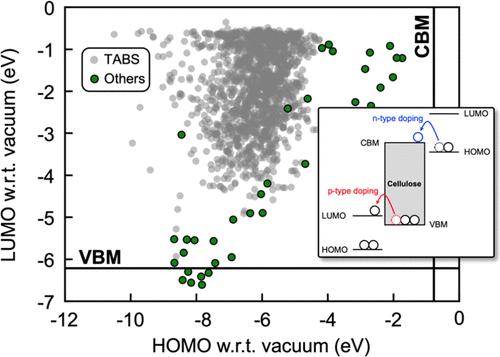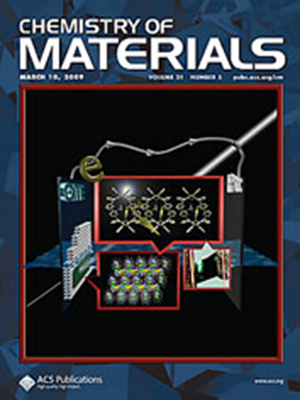纤维素纳米晶体的分子表面掺杂:高通量计算研究
IF 7.2
2区 材料科学
Q2 CHEMISTRY, PHYSICAL
引用次数: 0
摘要
纤维素是葡萄糖残基的线性聚合物,是地球上最丰富的生物聚合物。然而,由于纤维素不能导电,限制了它在柔性电子器件和储能设备中的应用。在此,我们进行了高通量第一原理计算筛选,以确定有希望用于纤维素纳米晶体(CNC)表面掺杂的分子。我们研究了 1600 多种分子,包括 TABS 数据库中的分子,以寻找 p 型和 n 型掺杂的候选分子。结果发现了几种 p 型掺杂剂,如六氰基三亚甲基环丙烷(CN6-CP)和八氰基二甲基醌(OCNQ)。然而,由于纤维素的电子亲和性较低,因此没有找到合适的 n 型掺杂剂。我们构建了纤维素 Iα 和 Iβ 晶体 CNC 的原子模型,展示了它们的电子带结构如何依赖于表面氢键重构。我们提出了一种通过操纵 Iα 表面氢键网络在 CNC 表面产生光电流的新机制。通过对表面吸附分子掺杂剂的 CNC 模型进行第一原理计算,进一步完善了潜在 p 型掺杂剂的选择。最后,我们证明了适当的表面官能化可以增强 CNC 的电子亲和力,从而部分克服 n 型掺杂带来的挑战。本文章由计算机程序翻译,如有差异,请以英文原文为准。

Molecular Surface Doping of Cellulose Nanocrystals: A High-Throughput Computational Study
Cellulose, a linear polymer of glucose residues, is the most abundant biopolymer on Earth. However, its inability to conduct electricity limits its applications in flexible electronics and energy storage devices. Here, we performed high-throughput first-principles computational screening to identify promising molecules for surface doping of cellulose nanocrystals (CNCs). We examined over 1600 molecules, including those from the TABS database, to find candidates for p-type and n-type doping. Our results identified several p-type dopants, such as hexacyano-trimethylene-cyclopropane (CN6-CP) and octacyanoquinodimethane (OCNQ). However, no suitable n-type dopants were found due to the low electron affinity of cellulose. We constructed atomic models of CNCs of cellulose Iα and Iβ crystals, showing how their electronic band structures depend on surface hydrogen bond reconstructions. We propose a novel mechanism for photocurrent generation in CNC Iα surfaces by manipulating the hydrogen bond network at the surfaces. The selection of potential p-type dopants was further refined through the first-principles calculations of the CNC models with molecular dopants adsorbed on the surface. Finally, we demonstrate that suitable surface functionalization can enhance the electron affinity of CNCs, partially overcoming the challenges of n-type doping.
求助全文
通过发布文献求助,成功后即可免费获取论文全文。
去求助
来源期刊

Chemistry of Materials
工程技术-材料科学:综合
CiteScore
14.10
自引率
5.80%
发文量
929
审稿时长
1.5 months
期刊介绍:
The journal Chemistry of Materials focuses on publishing original research at the intersection of materials science and chemistry. The studies published in the journal involve chemistry as a prominent component and explore topics such as the design, synthesis, characterization, processing, understanding, and application of functional or potentially functional materials. The journal covers various areas of interest, including inorganic and organic solid-state chemistry, nanomaterials, biomaterials, thin films and polymers, and composite/hybrid materials. The journal particularly seeks papers that highlight the creation or development of innovative materials with novel optical, electrical, magnetic, catalytic, or mechanical properties. It is essential that manuscripts on these topics have a primary focus on the chemistry of materials and represent a significant advancement compared to prior research. Before external reviews are sought, submitted manuscripts undergo a review process by a minimum of two editors to ensure their appropriateness for the journal and the presence of sufficient evidence of a significant advance that will be of broad interest to the materials chemistry community.
 求助内容:
求助内容: 应助结果提醒方式:
应助结果提醒方式:


